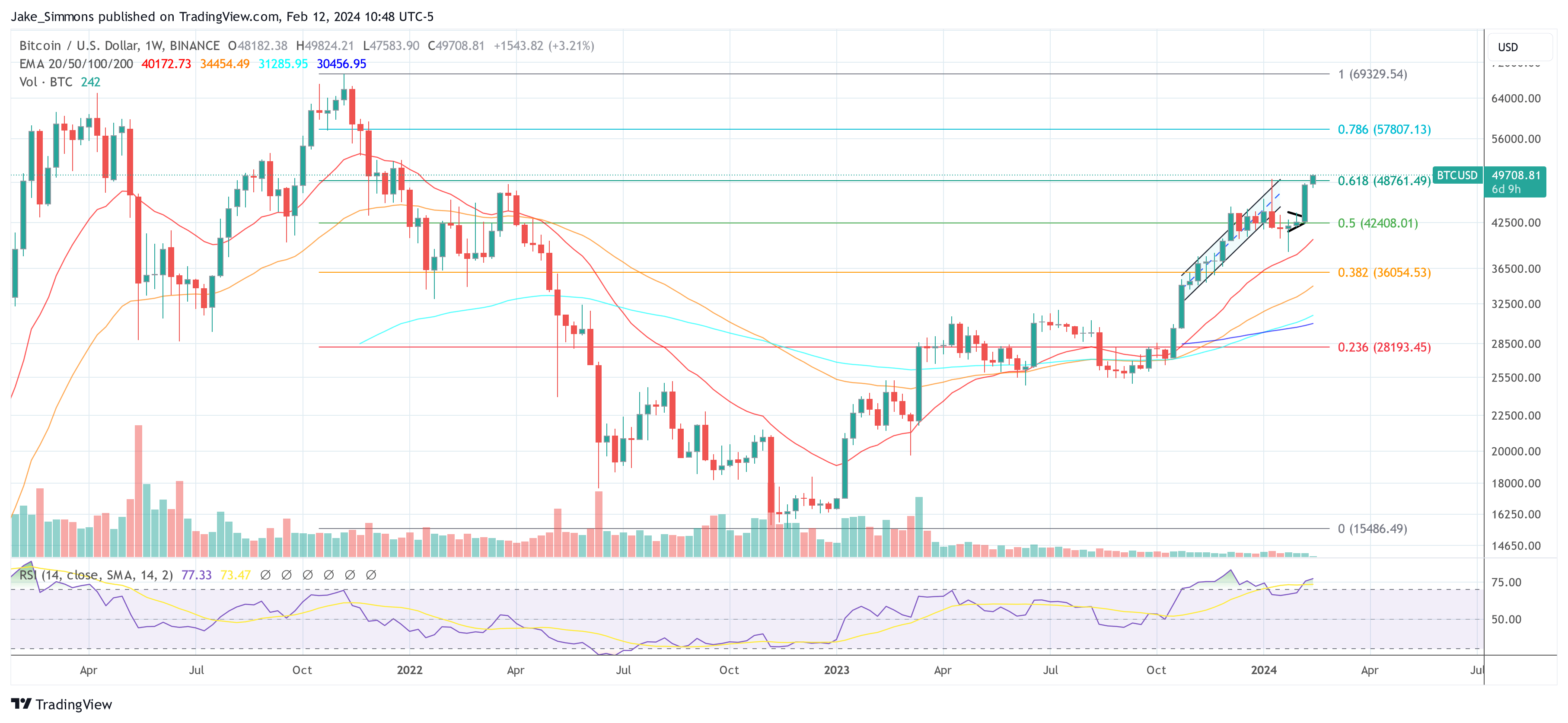In Grayscale’s latest report, “2024 Halving: This Time It’s Actually Different,” Michael Zhao, provides an in-depth analysis of the evolving dynamics within the Bitcoin ecosystem as the next halving event approaches in mid-April 2024. The report argues for a significant departure from previous cycles, underlined by the advent of spot Bitcoin ETFs in the United States, evolving investment flows, and innovative use cases emerging within the Bitcoin network.
The Essence Of Bitcoin Halvings
Halvings, designed to halve the reward for mining Bitcoin transactions every four years, are pivotal in maintaining Bitcoin’s scarcity and disinflationary profile. Zhao articulates, “This disinflationary characteristic stands as a fundamental appeal for many Bitcoin holders,” emphasizing the stark contrast with the unpredictable supplies of fiat currencies and precious metals.
Despite historical price surges post-halving, Zhao cautions against assuming such outcomes as guarantees, stating, “Given the highly anticipated nature of these events, if a price surge were a certainty, rational investors would likely buy in advance, driving up the price before the halving occurs.”
Distinguishing Factors Of The 2024 Halving
Macroeconomic Factors
According to Zhao, macroeconomic factors have differed in each cycle, however, always propelling the BTC price to new heights. The researcher describes the European debt crisis in 2012 as a significant catalyst for Bitcoin’s rise from $12 to $1,100, highlighting its potential as an alternative store of value amidst economic turmoil,
“Similarly, the Initial Coin Offering boom in 2016—which funneled over $5.6 billion into altcoins—indirectly benefited Bitcoin as well, pushing its price from $650 to $20k by December 2017. Most notably, during the 2020 COVID-19 pandemic, expansive stimulus measures […] [drove] investors towards Bitcoin as a hedge, which saw its price escalate from $8,600 to $68k by November 2021,” Zhao states.
Thus, Zhao suggests that while the halvings contribute to Bitcoin’s scarcity narrative, the broader economic context is also always critically impacting Bitcoin’s price.
Miners’ Strategic Adjustments
Anticipating the next BTC halving in April, miners have proactively adjusted their strategies to counterbalance the impending reduction in block reward income amidst escalating mining difficulties. Zhao observes a strategic move among miners, noting, “There was a noticeable trend of miners selling their Bitcoin holdings onchain in Q4 2023, presumably building liquidity ahead of the reduction in block rewards.
This foresight suggests miners are not merely reacting but are actively preparing to navigate the challenges ahead, ensuring the network’s resilience. “These measures collectively suggest that Bitcoin miners are well-positioned to navigate the upcoming challenges, at least in the short term,” the Grayscale researcher argues.
The Emergence Of Ordinals And Layer 2 Solutions
The introduction of Ordinal Inscriptions and the exploration of Layer 2 solutions have introduced new dimensions to Bitcoin’s functionality and scalability. Zhao emphasizes the significance of these innovations, stating, “Digital collectibles…have been inscribed, generating more than $200 million in transaction fees for miners.” This development has not only augmented Bitcoin’s utility but also provided miners with new avenues for revenue generation.
Furthermore, Zhao highlights the potential of Layer 2 solutions to address Bitcoin’s scalability challenges, pointing out, “The growing interest in Taproot-enabled wallets…indicates a collective move toward addressing these challenges.” This reflects a concerted effort within the Bitcoin community to enhance the network’s capabilities and accommodate a broader range of applications.
The Role Of ETF Flows
The approval and subsequent introduction of spot Bitcoin ETFs have significantly influenced Bitcoin’s market structure, facilitating wider access for investors and potentially mitigating sell pressure from mining rewards. Zhao articulates the impact of ETF flows, asserting, “Following US spot Bitcoin ETF approvals, the initial net flows…amounted to approximately $1.5 billion in just the first 15 trading days.”
This suggests that ETFs could play a crucial role in balancing the market dynamics post-halving by absorbing a significant portion of the typical sell pressure post-Halving. “In order to maintain current prices, a corresponding buy pressure of $14 billion annually is needed. Post-halving, these requirements will decrease by half: […] that equates to a decrease to $7 billion annually, effectively easing the sell pressure.”
A Promising Outlook for Bitcoin
According to Grayscale’s analysis, the next Bitcoin halving will be different for a number of reasons. Overall, the outlook is highly bullish:
Bitcoin has not only weathered the storm of the bear market but has also emerged stronger, challenging outdated perceptions with its evolution in the past year. While it has long been heralded as digital gold, recent developments suggest that Bitcoin is evolving into something even more significant.
At press time, BTC traded at $49,708.

Featured image created with DALLE, chart from TradingView.com
Disclaimer: The article is provided for educational purposes only. It does not represent the opinions of NewsBTC on whether to buy, sell or hold any investments and naturally investing carries risks. You are advised to conduct your own research before making any investment decisions. Use information provided on this website entirely at your own risk.
- SEO Powered Content & PR Distribution. Get Amplified Today.
- PlatoData.Network Vertical Generative Ai. Empower Yourself. Access Here.
- PlatoAiStream. Web3 Intelligence. Knowledge Amplified. Access Here.
- PlatoESG. Carbon, CleanTech, Energy, Environment, Solar, Waste Management. Access Here.
- PlatoHealth. Biotech and Clinical Trials Intelligence. Access Here.
- Source: https://www.newsbtc.com/news/bitcoin/grayscale-next-bitcoin-halving-different/



